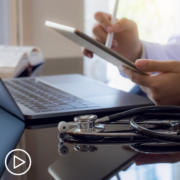What Multi-Language Technology Innovations Are Available for Cancer Patients and Families?
What Multi-Language Technology Innovations Are Available for Cancer Patients and Families? from Patient Empowerment Network on Vimeo.
What are available innovations for chronic lymphocytic leukemia (CLL) patients who speak languages besides English? Dr. Kathy Kim and Dr. Farrukh Awan share their perspectives on interpreter services and multi-language technology innovations for patients who need Spanish, Vietnamese, Korean, Chinese, and other languages for improving their CLL knowledge and care.
See More from Best CLL Care No Matter Where You Live
Related Resources:
Transcript:
Dr. Awan:
Another issue that we have seen is that some of our patients and we live in a town that has a substantial percentage of Hispanic-speaking or Spanish-speaking people, so we actually have access to a lot of resources and a lot of options for those patients, but there might be some limitations in people who don’t necessarily speak English as the first language, so what kind of tools do we have for those people, what kind of resources can they access to? So, Dr. Kim, anything for those patients?
Dr. Kim:
Yes, and we have really made an effort in our own research to any of the resources that we provide, the mobile applications that we use are available in multiple languages, and I will say Spanish is the most common one that we are able to support. Of course, there are many, many languages spoken in the United States, beyond English and Spanish that we do, we are challenged when we try to find other resources or applications that can be in Chinese and Korean and in other languages. It’s really challenging. So, in our own work, we have developed applications, and this is in research, so these are not things that are necessarily available in practice. We have developed applications for example, for care coordination for patients undergoing chemotherapy or to support shared decision-making at the beginning of your cancer journey between a patient and their family and a clinician, and when we develop those applications, as I said, we, obviously, I don’t speak Spanish, I only speak English, so I’m limited as to what I can develop. I can develop it in English, but then we always try to co-design it with clinicians who speak that language and with patients, so we do a lot of co-design with patients so that when we create it we’re making sure that it seems appropriate when it’s produced in other languages, and then we always test it with people who are native speakers in that language as well, so that’s one.
So many of the educational resources, our website information, our mobile applications, there is no reason why we can’t have those available in multiple languages. I think it is more challenging when you’re trying to build a relationship with a provider, with your doctor or with your nurse, or nurse practitioner and the patient don’t speak the same language, and then we have to rely on interpreter services. And I will say that that has not quite made the leap that we’d hoped with telehealth, to integrate an interpreter into your telehealth visit is quite challenging, and I’ve heard of doctors and patients being on a televisit and then the doctor calls the interpreter on their cell phone and tries to put that speaker up to the speaker on the computer, and that it’s not the best experience for anybody. So, that is an area that we would really like to work on, how do you have interpreter services really integrated into telehealth so it’s smooth for everybody.
Dr. Awan:
And let me share my experience, just this week, actually, on Monday, I was in clinic and we frequently have patients who speak Spanish, and we have in-person Spanish interpreters that are readily available, so one of my patients was a Spanish speaker, so I had the interpreter in the room with me, so that interaction went really well, the patient’s daughter was also obviously able to interpret some of that, so it was a fairly easy conversation, we explained, we talked about treatment options and what the plan is, so that went really well, My next patient was a Vietnamese speaking patient, so we don’t have those in person, so my nurse got me this iPad, which was on a mount, it’s like a dolly that can go from room to room, and I
turned it on and I was expecting some issues and they basically had a screen for me saying what language do you want, and I said Vietnamese, and then literally 30 seconds I was connected to a Vietnamese speaking interpreter, and they were able to see me, see the patient and the patient was able to see them. So, it was almost like having an interpreter in the room.
I think it always helps to have an interpreter in the room, in the event that you have to explain certain medical terminology, so my experience with this one application that our hospital subscribes to was very, very good.
I also found out that actually there are certain apps that if I want to print out a certain form or a certain patient education material and give it to the patient, okay, fine, this is the treatment you’re getting, these are the side effects, this is what to expect, there are options for translating it because they are already translated. You just hit the language you want, and that prints out the material in that language and you can give it to the patient to read, and I feel that that was a good resource to have. Similarly, being involved in multiple clinical trials, I feel that that is sometimes challenging option for a lot of patients, but I just wanna reassure everyone that all you have to do is ask. You can ask for a form in a specific language and it’s my responsibility, it’s my job to make sure that that translation is available to you so you can read it in your own language, and that is a service that is provided routinely by our cancer center, and I’m sure by a lot of other major academic centers and cancer centers in the country.






